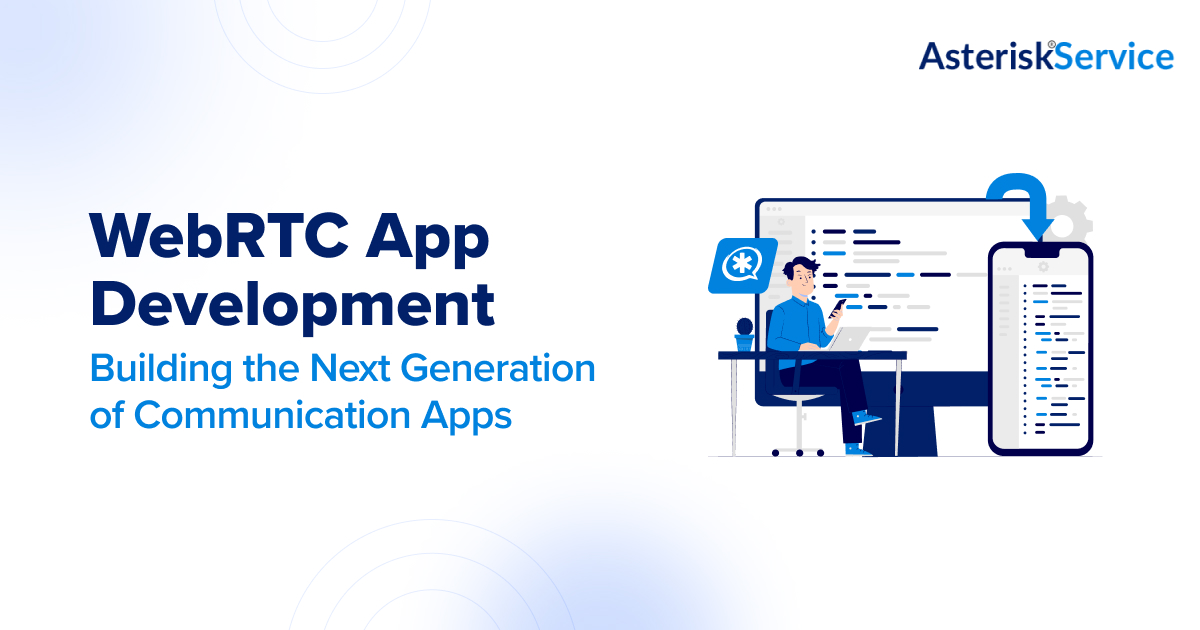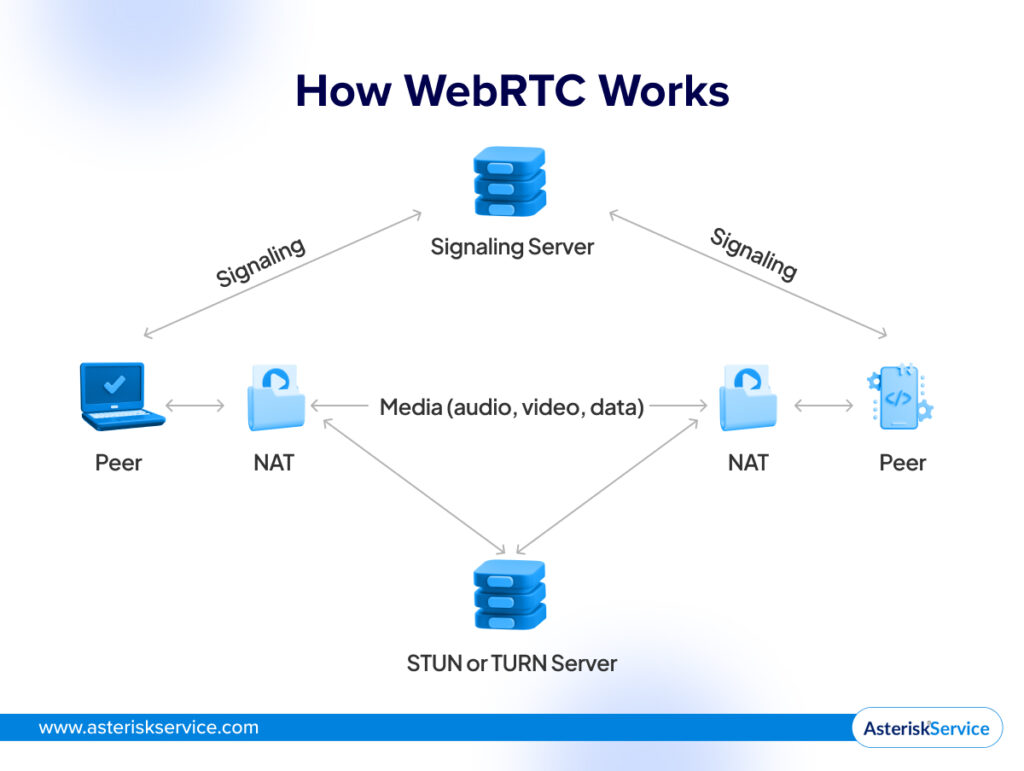
WebRTC (Web Real-time communication) is an open-source technology that enables peer-to-peer communication via the web without additional plugins. It facilitates real-time data and multimedia exchange within web browsers and the WebRTC mobile app. Leveraging WebRTC app development, businesses can build seamless, high-performing apps that support secure, real-time communication for video calls, voice interactions, and file sharing across platforms.
How Does a WebRTC Work?
If you are wondering how to build WebRTC app for your businesses, first let us know how it works!
WebRTC uses JavaScript, APIs, and Hypertext Markup Language to embed communication technologies within mobile applications and browsers.
- It directly connects two devices: browsers, mobile apps, or other endpoints. Once the connection is established, it bypasses the need for intermediary servers.
- WebRTC’s signaling process makes this direct connection possible. In this connection, peers exchange necessary metadata about each other, such as network information, codec support, and media formats, before the communication session begins.
- The signaling process relies on an external server to facilitate the initial exchange of information, such as the device’s IP addresses and ports, through Session Description Protocol (SDP).
- Once the information is exchanged, the end users will know how to connect. WebRTC employs Interactive Connectivity Establishment (ICE) to find the correct and available route to establish a connection.
- If firewalls or NAT configurations block the connection, WebRTC uses STUN servers to discover public IP addresses or TURN servers to pass on the data to a third-party server.
Once the connection is established, WebRTC ensures that the shared data between peers is encrypted using protocols such as SRTP for media exchange and DTLS for data channels. The end-to-end encryption ensures that the communication is secure and protected. WebRTC has bitrate controls that optimize media quality, ensuring smooth communication.
WebRTC is widely used in applications like video conferencing file sharing, allowing developers to build secure WebRTC apps that provide real-time activity and secure communication.

Functions of WebRTC
WebRTC app development offers an array of functions for seamless communication app development.
- Peer-to-peer Communication – WebRTC establishes connections between users’ devices, eliminating the need for plugins or centralized servers.
- Real-time Audio and Video Streaming – High-quality audio and WebRTC video streaming without latency and jittering, making it ideal for telecommunications and businesses.
- Data Channels – Developers create real-time data channels for sharing text, files, or other forms of data, such as collaboration tools or live gaming.
- Cross-platform Compatibility – WebRTC works on multiple platforms, including browsers like Chrome and Firefox or the WebRTC mobile app in Android or iOS, making it easily accessible to a broader audience.
Advanced Features of WebRTC Apps
Below are some features of WebRTC apps:
- Security & Encryption – WebRTC uses SRTP and DTLP protocols to protect against vulnerable threats such as phishing or man-in-the-middle attacks.
- Integration with AI and Machine Learning – AI and ML-integrated WebRTC communication enables facial recognition and transcript recognition, which converts real-time speech into text for video and sentiment analytics.
- Cloud Recording – WebRTC doesn’t natively support recording. Still, by integrating AWS services like S3 (storage) and Lambda (for event-driven workflows), developers can add functionality to record and store audio or video calls for future reference, compliance, or analysis.
(Also Read: Why do businesses need customer WebRTC development solutions?)
Challenges and Concerns
WebRTC has many tweaks and perks, but there are some challenges while you build WebRTC app for your business or enterprise.
- Latency & Bandwidth Management – Real-time communication apps are sensitive to network conditions. Handling low-bandwidth environments requires adaptive bitrate streaming while minimizing latency in video calls, which requires efficient packet prioritization.
- Compatibility Issues – While WebRTC is supported by most modern browsers and platforms, minor differences in implementation can cause compatibility issues. To ensure seamless performance, developers must run a health test across servers, devices, and operating systems.
- Security Concerns – As discussed above, the primary concern in WebRTC is ensuring security from external threats like eavesdropping and DDoS attacks, which can be prevented more effectively by using SBCs and firewalls to secure WebRTC apps.
Conclusions
As the need for real-time communication apps continues to grow, integrating WebRTC with AWS’s scalable cloud infrastructure will become critical in building efficient, feature-rich, and secure applications for various industries. Developers and businesses should explore Asterisk Service-WebRTC to leverage the power of real-time communication and AWS’s infrastructure to create the next generation of scalable, reliable, and secure communication solutions.
FAQs
1. What is WebRTC, and why is it essential for app development?
WebRTC (Web Real-Time Communication) is a technology that enables real-time audio, video, and data sharing between web browsers and mobile applications without plugins. It’s essential for building interactive, real-time communication apps like video conferencing, chat, and live streaming.
2. How secure is WebRTC?
WebRTC offers built-in security features like end-to-end encryption for media streams, data channel encryption, and secure authentication mechanisms, helping protect user privacy.
3. What are the key features of WebRTC?
WebRTC supports real-time audio, video, and data transfer, peer-to-peer communication, adaptive bitrate streaming, encryption, and cross-platform compatibility, making it ideal for applications needing real-time interaction.
4. What types of applications can be built with WebRTC?
Using WebRTC we can build video conferencing tools, voice chat apps, telehealth platforms, live streaming, online gaming, customer support chat, and collaborative tools.
5. Which platforms are compatible with WebRTC?
WebRTC is compatible with web browsers (Chrome, Firefox, Safari, Edge), Android, and iOS, enabling cross-platform functionality for web and mobile applications.